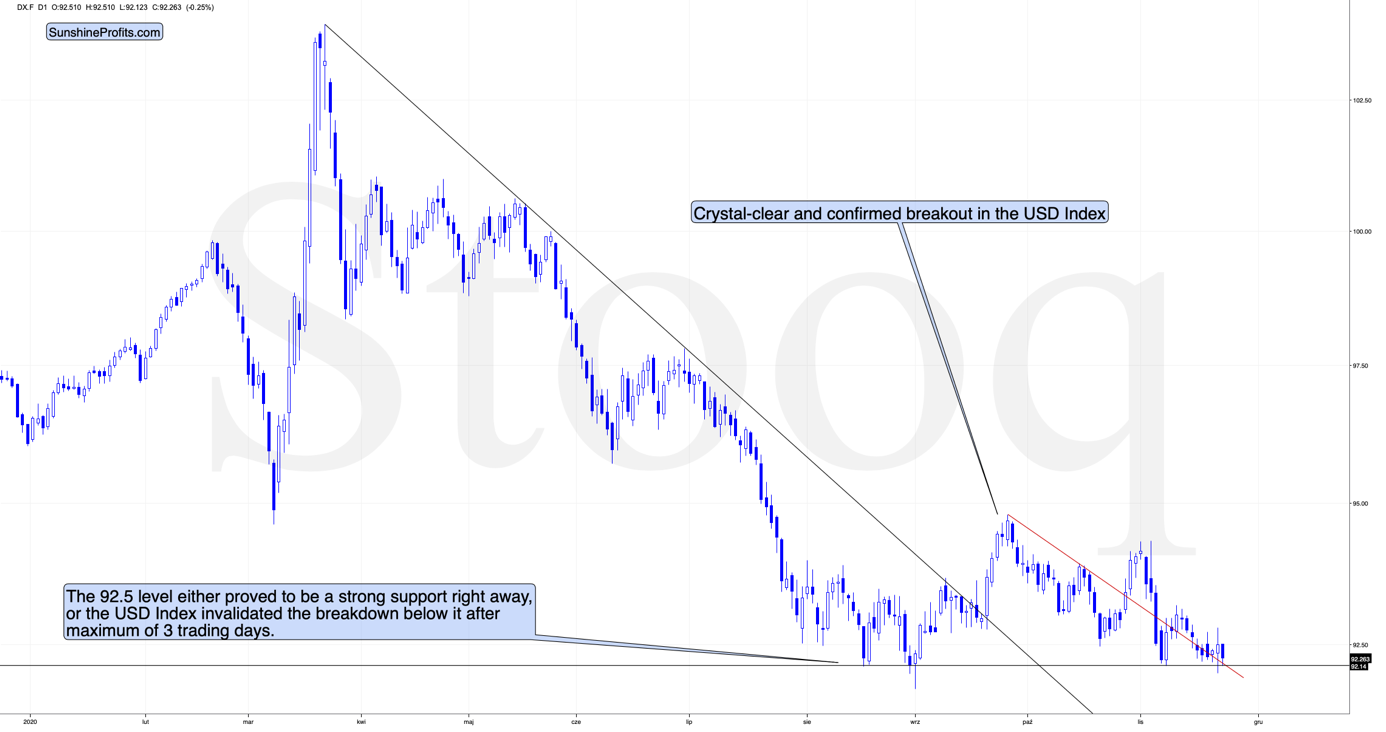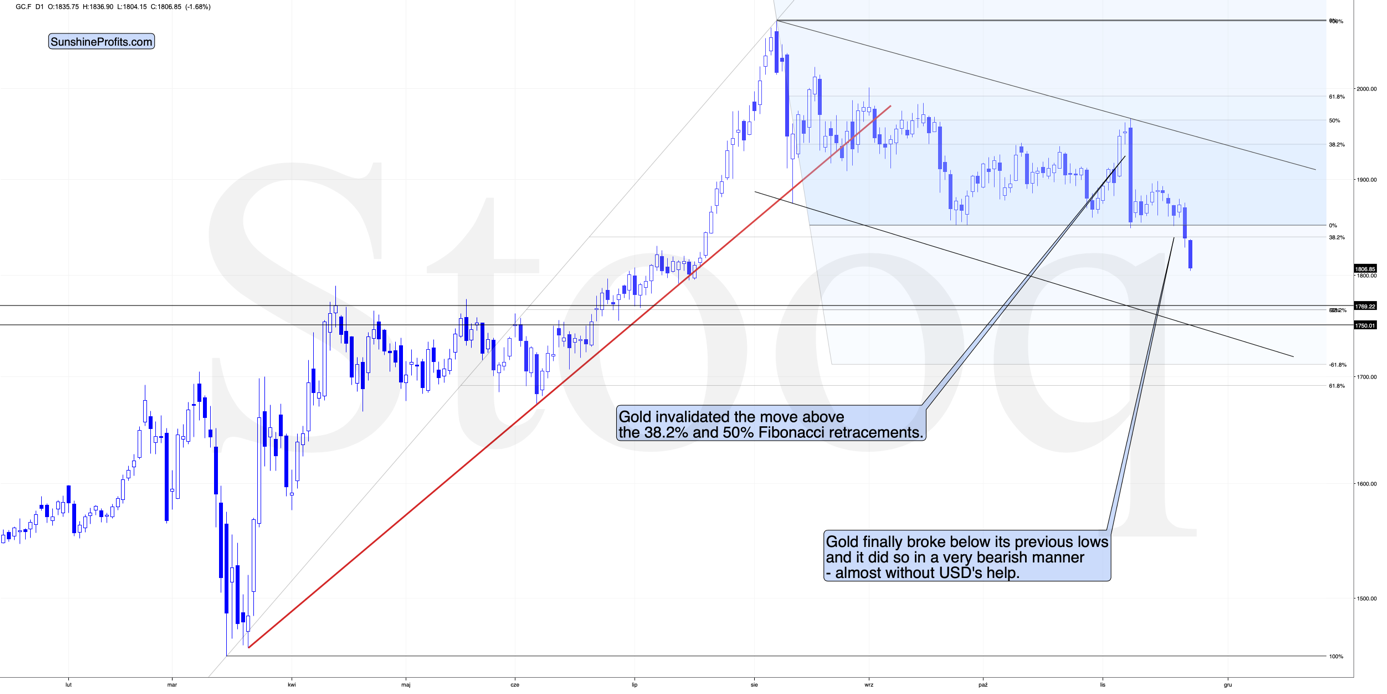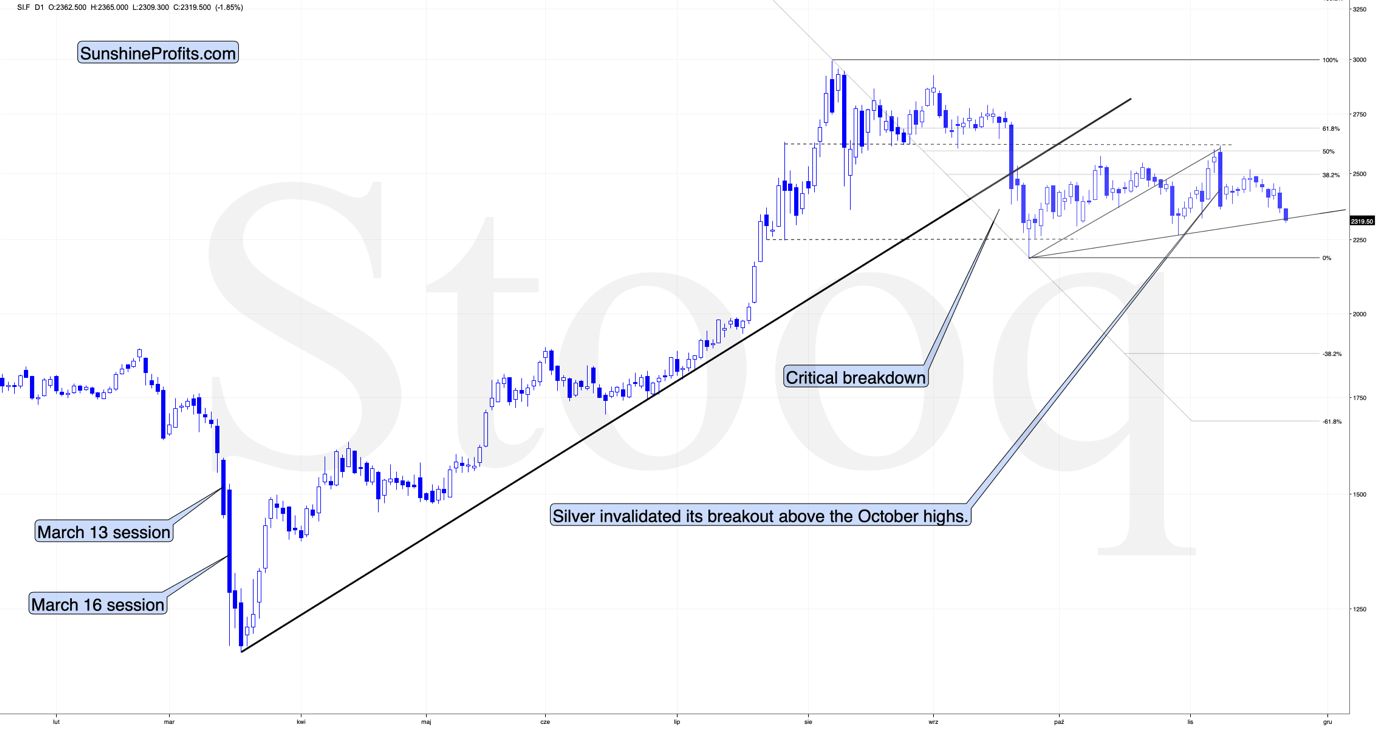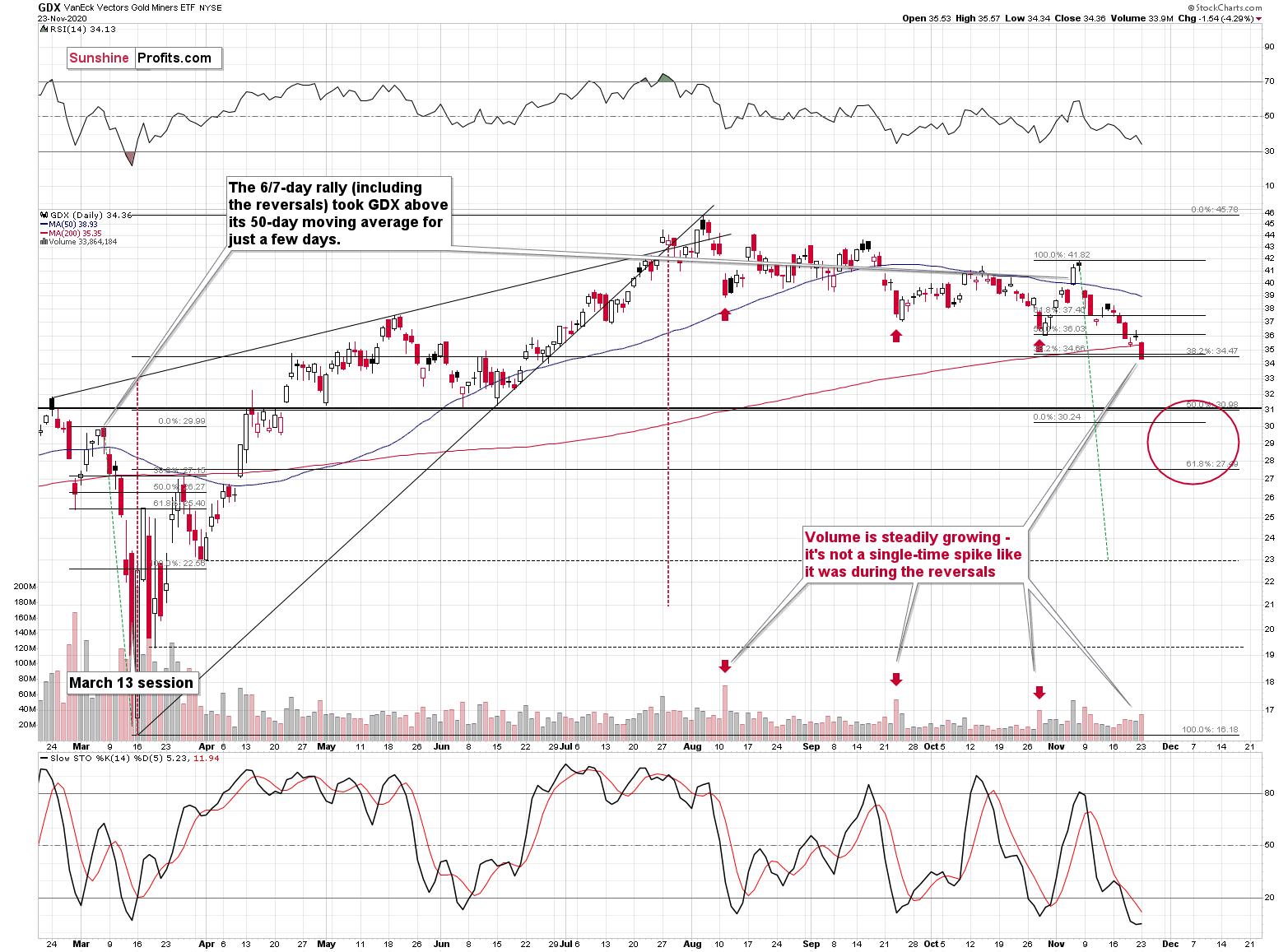Briefly: in our opinion, full (300% of the regular position size) speculative short positions in mining stocks are justified from the risk/reward point of view at the moment of publishing this Alert.
Approximately two weeks ago gold plunged about $100 and we received a few messages saying that there was nothing technical about this move, and it was just a reaction to the potential Covid-19 vaccine. Well, what about now? During today’s pre-market trading gold was down about $75 counting from Friday’s intraday high – what is this in response to? The U.S. Dollar Index and the stock market haven’t moved in any significant manner and no major news hit the market. Why did gold decline?
Because things are not as simple as news-price-reaction models would have one believe. People’s interpretation of events is what matters – whether we’re discussing the performance of markets or any other life situation in general.
Let’s consider a bank robbery, during which precisely one person gets shot and it’s in the arm - without any major impact on their life (heals relatively quickly, no long-lasting damage). Was this person unlucky or lucky?
The event was clear and objective. But what about the interpretation?
If one chooses the following interpretation: they could have been shot fatally and/or many other people could have been shot - then based on what really happened, this person was lucky.
However, if one chooses the following alternative: they could have simply stayed home or there might have been no robbery at all - then based on what really happened, this person was unlucky (wrong place, wrong time).
Therefore, the feelings and implications garnered from the situation depend entirely on the person and how they subjectively interpret these scenarios.
The above example (taken from the book, The Happiness Advantage by Shawn Achor, which I highly recommend) can be applied to markets as well. The markets are bombarded with news every day. Some news is more important than others, and sometimes when a more important event takes place (or when something trivial happens), the markets move. But they move because they (markets = market participants) interpret a given situation in a specific way. And the way they choose to interpret news and events depends on the stage of a particular cycle that they’re in.
Do the markets want to move lower? If so, they will overreact to the bearish pieces of news, and will more or less downplay the bullish ones – either immediately or shortly thereafter. Did gold plunge two weeks ago based on the news regarding the Covid-19 vaccine? Yes, but the extent of the decline was based on something deeper. It could have declined about $15, right?
The current price movement proves that what we saw two weeks ago was indeed much more than just a reaction to news. Gold just plunged even without any major news announcement. In fact, it declined even without the most obvious trigger that it was likely to get – a rally in the USD Index.
What does it all mean? It means that while it’s not possible to predict unexpected news like a Covid-19 vaccine, it’s still possible to detect a large part of the market’s movements. This is possible thanks to the techniques aimed at detecting at which stage the market is at and what it wants to do next. Some of these gold trading tips include looking at the relative performance of gold vs the USDX and gold miners vs. gold, but there are many additional ones that one can use.
All things considered, it should now be obvious to everyone that gold wanted – and likely still wants – to move lower before soaring.
So, what’s next?
First of all, I previously wrote that gold might bounce from about the $1,800 level. I think this is no longer likely. Why? Because gold is already almost right at this level and the USD Index hasn’t rallied yet.
The USD Index refused to decline below the mid-August lows and the invalidation of the tiny breakdown was enough to trigger the slide in gold. In yesterday’s analysis, I commented on the above chart in the following way:
At the moment of writing these words, the U.S. currency is testing the previous lows. It’s very near to the last daily close price of 2020. At the same time, the USDX is below the 92.5 level, which is much more important than it seems at the first sight. Previously, in 2020, the USDX managed to stay below this level for a maximum of 2 sessions. This is currently the fifth session below it. Normally, this could be viewed as an early sign of a breakdown, but I don’t think this would be the proper interpretation.
Given the Thanksgiving seasonality, and the fact that the small breakdown below 92.5 didn’t result in a breakdown below the previous price lows, it’s doubtful that there are any bearish implications at all. Besides, that’s not even the most important detail from the precious metals investors’ point of view.
The most important detail is that all these bearish moves in the USDX failed to trigger any decent rallies in gold, which shows that the latter simply doesn’t want to rally from here.
The fact that gold declined so much based on just the USD’s inability to decline more is very telling. Precisely, because it tells us how much gold actually wants to slide, and how impatient it got with the lack of bearish triggers.
Since gold broke below the previous lows practically on its own, and it seems that it’s about to get a bearish push from the rising USD Index (it seems to have completed its broad bottom). Consequently, it’s likely that it will decline more than just an additional $10 or so when the USDX finally rallies.
Actually, it’s likely to decline much more. Based on the 50% Fibonacci retracement based on the entire 2020 rally, on the 138.2% Fibonacci extension based on the initial August – September decline, and on the April high in terms of the daily closing prices, the next short-term target is at about $1,770.
Still, I wouldn’t be surprised to see gold decline even more before it reverses. Based on the declining trend channel (the line that’s parallel to the line based on the August and November highs), gold could decline to about $1,750 or so (another $50) before bouncing.
And yes, “bouncing” not “bottoming”. If gold was able to decline as much without the USD’s help, then it’s likely to slide much more when the USD Index finally rallies. The bullish potential for the latter is significant, so gold could continue to slide well below $1,700 before bottoming.
On the other hand, there are multiple techniques pointing to $1,700 as strong support, which suggests an important rebound from this level. Will it be THE bottom? It’s a tough call to say at this time. As I wrote many times previously, it will be gold’s ability to hold strong despite USD’s rallies that will be the final bullish call. At this time, we have gold declining even without the USD’s help.
While gold is already significantly below its previous lows, silver is not yet at its own recent lows.
In fact, it’s holding up relatively well despite gold’s and miners’ bearish lead. This is in tune with my expectations. For weeks, I’ve been writing about the likelihood that miners will be the first to accelerate their decline, and that at some point they will be likely to pass this “bearish outperformance” baton to silver. That’s exactly what happened during the March decline, and it seems that what we see right now is what we saw back then, but slower.
Please note the March 13 and March 16 sessions marked on the above chart. Taking the March 13 session into account, about half of the entire Q1 decline was over. It was the next day (March 16) that took silver to its final low. Precisely, silver moved even a bit lower in the next few days, but it was the March 16 session that was the key intraday bottom.
Now, let’s see what the miners – the GDX ETF – did on March 13 and March 16.
Miners bottomed on March 13 in terms of the daily closing prices and their March 16 intraday bottom was only slightly below the March 13 intraday low. On March 16, miners were already soaring, while silver plunged.
Does the history have to repeat? Absolutely not. However, the analogy to how the precious metals market declined in March is the best one that we’ve got. It’s the most recent one, and the fundamental situation is also quite similar. Back then, Covid-19 cases were soaring and they are soaring right now as well. There might be vaccines available, but it’s quite unclear how many people will take them. There are many more cases now, but the threat is now known, whereas previously it was unknown. So right now the situation is similar but more steady.
This means that the current situation – sliding miners and relatively strong silver – is normal, and it serves as a confirmation that the history is being repeated. What does it mean going forward? That in the following days miners might slide even more profoundly, but then – within the next 1-2 weeks – silver is likely to catch up in a major way.
Our goal here is to try to catch the moment when miners are already past most of their decline while silver is still before its decline’s midpoint. Thanks to this approach, we aim to squeeze more profits from this short trade than we would be able to do with just miners alone.
Hopefully, when gold slides to $1,750 or so, miners will be past a ridiculous decline (while silver will only be past a moderate decline) and thus it will be clear that it’s a good idea to switch from a short position in miners to a short position in silver.
Overview of the Upcoming Decline
As far as the current overview of the upcoming decline is concerned, I think it has already begun.
During the final part of the slide (which could end within the next 1-5 weeks or so), I expect silver to decline more than miners. That would align with how the markets initially reacted to the Covid-19 threat.
The impact of all the new rounds of money printing in the U.S. and Europe on the precious metals prices is incredibly positive in the long run, which does not make the short-term decline improbable. Markets can and will get ahead of themselves and decline afterward – sometimes very profoundly – before continuing with their upward climb.
The plan is to exit the current short positions in miners after they decline far and fast, but at the same time, silver drops just “significantly” (we expect this to happen in 0 – 3 weeks). In other words, the decline in silver should be severe, but the decline in the miners should look “ridiculous”. That’s what we did in March when we bought practically right at the bottom. It is a soft, but simultaneously broad instruction, so additional confirmations are necessary.
I expect this confirmation to come from gold, reaching about $1,750. If – at the same time – gold moves to about $1,750 and miners are already after a ridiculously big drop (say, to $31 - $32 in the GDX ETF – or lower), we will probably exit the short positions in the miners and at the same time enter short positions in silver. However, it could also be the case that we’ll wait for a rebound before re-entering short position in silver – it’s too early to say at this time.
The precious metals market's final bottom is likely to take shape when gold shows significant strength relative to the USD Index. It could take the form of a gold’s rally or a bullish reversal, despite the ongoing USD Index rally.
Summary
Summing up, the next big move lower in the precious metals market is definitely underway and it seems that it will take another 1-5 weeks (likely in mid-December or in its second half) before the decline ends. For now, the miners are still declining significantly, while silver is showing relative strength – we expect this to reverse in the final part of the decline.
Please note that even Warren Buffett is limiting his exposure to gold.
As the USD Index appears to have ended forming its broad bottom pattern, it’s likely to rally, causing gold to slide. At some point gold is likely to stop responding to dollar’s bearish indications, and based on the above analysis, it seems that we might expect this to take place in December.
Naturally, everyone's trading is their responsibility. But in our opinion, if there ever was a time to either enter a short position in the miners or increase its size if it was not already sizable, it's now. We made money on the March decline, and on the March rebound, with another massive slide already underway.
After the sell-off (that takes gold to about $1,700 or lower), we expect the precious metals to rally significantly. The final decline might take as little as 1-5 weeks, so it's important to stay alert to any changes.
Most importantly, please stay healthy and safe. We made a lot of money on the March decline and the subsequent rebound (its initial part) price moves (and we'll likely earn much more in the following weeks and months), but you have to be healthy to enjoy the results.
As always, we'll keep you - our subscribers - informed.
To summarize:
Trading capital (supplementary part of the portfolio; our opinion): Full speculative short positions (300% of the full position) in mining stocks is justified from the risk to reward point of view with the following binding exit profit-take price levels:
Senior mining stocks (price levels for the GDX ETF): binding profit-take exit price: $32.02; stop-loss: none (the volatility is too big to justify a SL order in case of this particular trade); binding profit-take level for the DUST ETF: $28.73; stop-loss for the DUST ETF: none (the volatility is too big to justify a SL order in case of this particular trade)
Junior mining stocks (price levels for the GDXJ ETF): binding profit-take exit price: $42.72; stop-loss: none (the volatility is too big to justify a SL order in case of this particular trade); binding profit-take level for the JDST ETF: $21.22; stop-loss for the JDST ETF: none (the volatility is too big to justify a SL order in case of this particular trade)
For-your-information targets (our opinion; we continue to think that mining stocks are the preferred way of taking advantage of the upcoming price move, but if for whatever reason one wants / has to use silver or gold for this trade, we are providing the details anyway. In our view, silver has greater potential than gold does):
Silver futures downside profit-take exit price: unclear at this time - initially, it might be a good idea to exit, when gold moves to $1,703.
Gold futures downside profit-take exit price: $1,703
Long-term capital (core part of the portfolio; our opinion): No positions (in other words: cash
Insurance capital (core part of the portfolio; our opinion): Full position
Whether you already subscribed or not, we encourage you to find out how to make the most of our alerts and read our replies to the most common alert-and-gold-trading-related-questions.
Please note that we describe the situation for the day that the alert is posted in the trading section. In other words, if we are writing about a speculative position, it means that it is up-to-date on the day it was posted. We are also featuring the initial target prices to decide whether keeping a position on a given day is in tune with your approach (some moves are too small for medium-term traders, and some might appear too big for day-traders).
Additionally, you might want to read why our stop-loss orders are usually relatively far from the current price.
Please note that a full position doesn't mean using all of the capital for a given trade. You will find details on our thoughts on gold portfolio structuring in the Key Insights section on our website.
As a reminder - "initial target price" means exactly that - an "initial" one. It's not a price level at which we suggest closing positions. If this becomes the case (like it did in the previous trade), we will refer to these levels as levels of exit orders (exactly as we've done previously). Stop-loss levels, however, are naturally not "initial", but something that, in our opinion, might be entered as an order.
Since it is impossible to synchronize target prices and stop-loss levels for all the ETFs and ETNs with the main markets that we provide these levels for (gold, silver and mining stocks - the GDX ETF), the stop-loss levels and target prices for other ETNs and ETF (among other: UGL, GLL, AGQ, ZSL, NUGT, DUST, JNUG, JDST) are provided as supplementary, and not as "final". This means that if a stop-loss or a target level is reached for any of the "additional instruments" (GLL for instance), but not for the "main instrument" (gold in this case), we will view positions in both gold and GLL as still open and the stop-loss for GLL would have to be moved lower. On the other hand, if gold moves to a stop-loss level but GLL doesn't, then we will view both positions (in gold and GLL) as closed. In other words, since it's not possible to be 100% certain that each related instrument moves to a given level when the underlying instrument does, we can't provide levels that would be binding. The levels that we do provide are our best estimate of the levels that will correspond to the levels in the underlying assets, but it will be the underlying assets that one will need to focus on regarding the signs pointing to closing a given position or keeping it open. We might adjust the levels in the "additional instruments" without adjusting the levels in the "main instruments", which will simply mean that we have improved our estimation of these levels, not that we changed our outlook on the markets. We are already working on a tool that would update these levels daily for the most popular ETFs, ETNs and individual mining stocks.
Our preferred ways to invest in and to trade gold along with the reasoning can be found in the how to buy gold section. Furthermore, our preferred ETFs and ETNs can be found in our Gold & Silver ETF Ranking.
As a reminder, Gold & Silver Trading Alerts are posted before or on each trading day (we usually post them before the opening bell, but we don't promise doing that each day). If there's anything urgent, we will send you an additional small alert before posting the main one.
Thank you.
Sincerely,
Przemyslaw Radomski, CFA
Editor-in-chief, Gold & Silver Fund Manager
Sunshine Profits: Effective Investment through Diligence and Care







